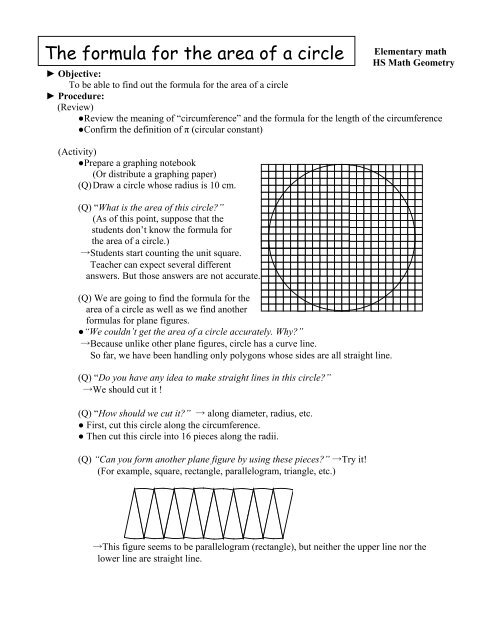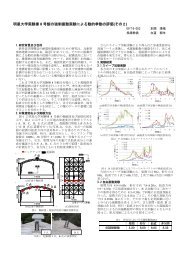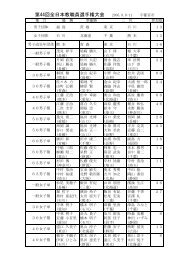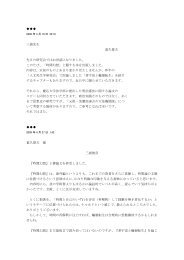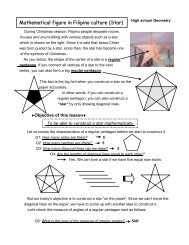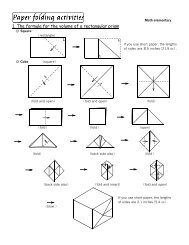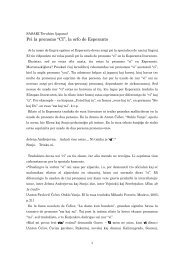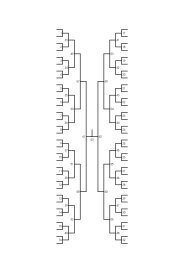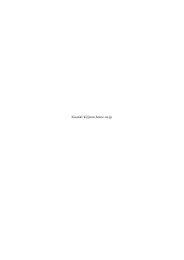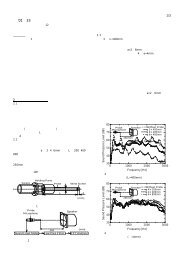The formula for the area of a circle
The formula for the area of a circle
The formula for the area of a circle
Create successful ePaper yourself
Turn your PDF publications into a flip-book with our unique Google optimized e-Paper software.
<strong>The</strong> <strong><strong>for</strong>mula</strong> <strong>for</strong> <strong>the</strong> <strong>area</strong> <strong>of</strong> a <strong>circle</strong>Elementary mathHS Math Geometry► Objective:To be able to find out <strong>the</strong> <strong><strong>for</strong>mula</strong> <strong>for</strong> <strong>the</strong> <strong>area</strong> <strong>of</strong> a <strong>circle</strong>► Procedure:(Review)●Review <strong>the</strong> meaning <strong>of</strong> “circumference” and <strong>the</strong> <strong><strong>for</strong>mula</strong> <strong>for</strong> <strong>the</strong> length <strong>of</strong> <strong>the</strong> circumference●Confirm <strong>the</strong> definition <strong>of</strong> π (circular constant)(Activity)●Prepare a graphing notebook(Or distribute a graphing paper)(Q) Draw a <strong>circle</strong> whose radius is 10 cm.(Q) “What is <strong>the</strong> <strong>area</strong> <strong>of</strong> this <strong>circle</strong>?”(As <strong>of</strong> this point, suppose that <strong>the</strong>students don’t know <strong>the</strong> <strong><strong>for</strong>mula</strong> <strong>for</strong><strong>the</strong> <strong>area</strong> <strong>of</strong> a <strong>circle</strong>.)→Students start counting <strong>the</strong> unit square.Teacher can expect several differentanswers. But those answers are not accurate.(Q) We are going to find <strong>the</strong> <strong><strong>for</strong>mula</strong> <strong>for</strong> <strong>the</strong><strong>area</strong> <strong>of</strong> a <strong>circle</strong> as well as we find ano<strong>the</strong>r<strong><strong>for</strong>mula</strong>s <strong>for</strong> plane figures.●“We couldn’t get <strong>the</strong> <strong>area</strong> <strong>of</strong> a <strong>circle</strong> accurately. Why?”→Because unlike o<strong>the</strong>r plane figures, <strong>circle</strong> has a curve line.So far, we have been handling only polygons whose sides are all straight line.(Q) “Do you have any idea to make straight lines in this <strong>circle</strong>?”→We should cut it !(Q) “How should we cut it?” → along diameter, radius, etc.● First, cut this <strong>circle</strong> along <strong>the</strong> circumference.● <strong>The</strong>n cut this <strong>circle</strong> into 16 pieces along <strong>the</strong> radii.(Q) “Can you <strong>for</strong>m ano<strong>the</strong>r plane figure by using <strong>the</strong>se pieces?” →Try it!(For example, square, rectangle, parallelogram, triangle, etc.)→This figure seems to be parallelogram (rectangle), but nei<strong>the</strong>r <strong>the</strong> upper line nor <strong>the</strong>lower line are straight line.
(Q) “If we cut this <strong>circle</strong> into small pieces, what shape can we <strong>for</strong>m?”Cut and arrange again.<strong>The</strong> upper line and <strong>the</strong> lower line are almost to straight lines.(Q) “What will happen if we divide this <strong>circle</strong> into 100 pieces and arrange it?”→<strong>The</strong> shape will be closest to real parallelogram (rectangle).(Q) “Which part <strong>of</strong> <strong>the</strong> <strong>circle</strong> corresponds to <strong>the</strong> height (length)?”“Which part <strong>of</strong> <strong>the</strong> <strong>circle</strong> corresponds to <strong>the</strong> base (width)?”●height (length) → radius●base (width) → circumference<strong>The</strong> <strong><strong>for</strong>mula</strong> <strong>for</strong> <strong>the</strong> <strong>area</strong> <strong>of</strong> a parallelogram = base×height(<strong>The</strong> <strong><strong>for</strong>mula</strong> <strong>for</strong> <strong>the</strong> <strong>area</strong> <strong>of</strong> a rectangle = length×width)(Write on <strong>the</strong> board)▲Let’s try to make <strong>the</strong> <strong><strong>for</strong>mula</strong> !▲<strong>The</strong> <strong>area</strong> <strong>of</strong> <strong>the</strong> <strong>circle</strong>= <strong>The</strong> <strong>area</strong> <strong>of</strong> <strong>the</strong> parallelogram (rectangle)=base × height (length×width)=radius×circumference÷2=radius×radius×2×π÷2(circumference=radius×2×π)=radius×radius×π<strong>The</strong>re<strong>for</strong>e,<strong>The</strong> <strong><strong>for</strong>mula</strong> <strong>for</strong> <strong>the</strong> <strong>area</strong> <strong>of</strong> a <strong>circle</strong>=radius×radius×π(Generalization)●Assessment(Exercise) Radius = 5cm.What is <strong>the</strong> <strong>area</strong> <strong>of</strong> this <strong>circle</strong>?<strong>The</strong> <strong>area</strong> <strong>of</strong> this <strong>circle</strong> = 5×5×π=25π(cm)
Ano<strong>the</strong>r way <strong>of</strong> deriving <strong>the</strong> <strong><strong>for</strong>mula</strong> <strong>for</strong> <strong>the</strong> <strong>area</strong> <strong>of</strong> a <strong>circle</strong>Circle↔Triangle►ObjectiveTo be able to derive <strong>the</strong> <strong><strong>for</strong>mula</strong> <strong>for</strong> <strong>the</strong> <strong>area</strong> <strong>of</strong> a <strong>circle</strong>(Through <strong>the</strong> activity, students would be surprised at <strong>the</strong> unexpected result and derive <strong>the</strong> <strong><strong>for</strong>mula</strong><strong>for</strong> <strong>the</strong> <strong>area</strong> <strong>of</strong> a <strong>circle</strong> in an actual setting)►Procedure?Draw a <strong>circle</strong> whose radius is 3 cm.Put <strong>the</strong> double sides tape on<strong>the</strong> illustration boardMake a hole at <strong>the</strong> center <strong>of</strong>a <strong>circle</strong>Roll <strong>the</strong> yarn around acylindrical object and fix it to<strong>the</strong> desk by using a rulerPut a yarn through <strong>the</strong> holeand fix it at <strong>the</strong> back by usingscotch tapeFrom <strong>the</strong> center <strong>of</strong> <strong>the</strong> <strong>circle</strong>,roll <strong>the</strong> yarn to <strong>the</strong> circumferenceCut <strong>the</strong> yarn from <strong>the</strong>center to <strong>the</strong> circumferenceFrom <strong>the</strong> circumference, arrange <strong>the</strong> cut yarnsfrom <strong>the</strong> longest yarn at <strong>the</strong> bottom to <strong>the</strong>shortest yarn at <strong>the</strong> top to create a straight lineWe can <strong>for</strong>m a triangle<strong>The</strong> <strong><strong>for</strong>mula</strong> <strong>for</strong> <strong>the</strong> <strong>area</strong> <strong>of</strong> a triangle1= × base × height2<strong>The</strong> <strong><strong>for</strong>mula</strong> <strong>for</strong> <strong>the</strong> <strong>area</strong> <strong>of</strong> a <strong>circle</strong>1= × circumffer ence×radius21= × diamiter × π × radius2= π × radius × radiusAteneo De Davao University – Regional Science Teaching Center


